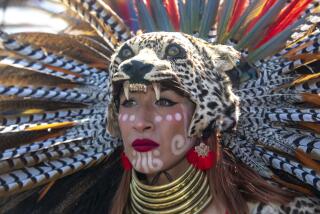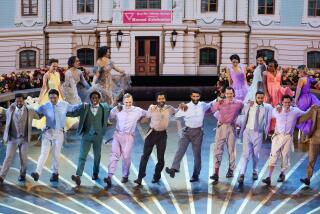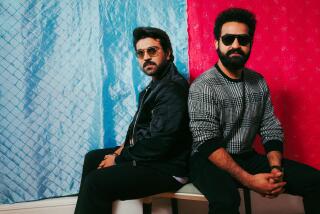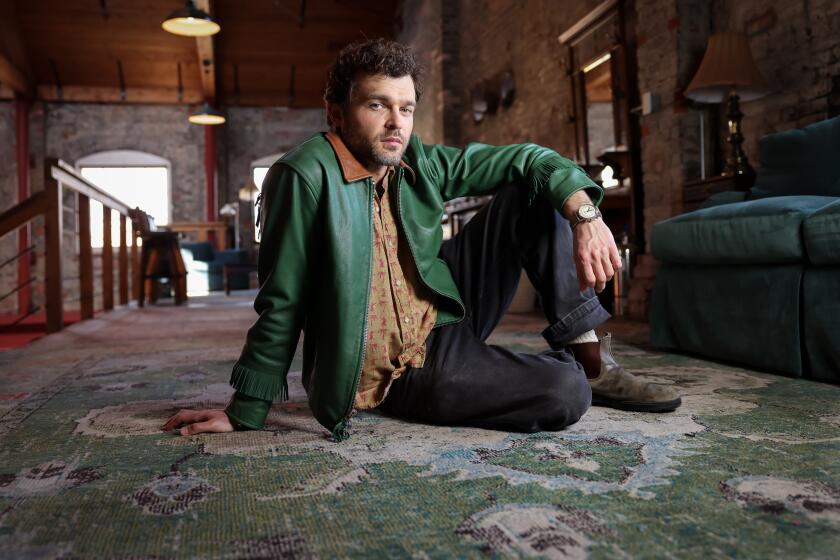An India rarely seen on the Western stage
- Share via
Although dancers and musicians specializing in the ancient classical idioms of India frequently perform in America, other exciting Indian traditions remain rarities on our stages.
On Sunday, the locally based Rangoli Foundation helped widen our perceptions with a fascinating program in the Barnsdall Park Gallery Theatre juxtaposing the vibrant classicism of Bharata Natyam with colorful folk dances from South India and even a demonstration of Indian martial arts.
Live music and choreography largely by Malathi Iyengar (Rangoli artistic director) distinguished the classical selections. “Maate Malayadhwaja,” an extended solo for Lakshmi Iyengar, the choreographer’s daughter, depicted a woman extraordinary in so many ways that she attracted the interest of the great Lord Shiva.
Beginning with simple, forceful steps and bold changes of arm position, the solo accelerated and grew more complex -- alternating between pure percussive footwork and narrative sequences requiring a mastery of expressive gesture.
Dressed in green and gold, Iyengar brought technical skill and emotional involvement to the solo, adroitly matching steps to the rhythms of the accompaniment in some moments but elsewhere managing to float free of the music, her concentration taking her deeply into a world of gods, demons and miraculous transcendence.
With repetitions set in a circle, the choreography let us see the movement from many angles and always made the dancer’s long, long arms look heroic if not downright supernatural.
The Rangoli women performed their two classical showpieces with authority and then returned to demonstrate their versatility in the very different vocabularies of folk dances from Andhra Pradesh, Rajasthan and Karnataka.
Gone the gestural thrust and sharp step-attacks of Bharata Natyam. Instead, soft, mobile hands and bouncy footwork kept the line dancing of “Dhimsa,” the delicate shoulder-touches of “Ghoomar” and the playful formation shifts of “Mathanadannayya” in high relief.
Choreographed to taped music by Murali Mohan K. (a guest from India, along with three of the classical musicians), these pieces occasionally looked overloaded with good ideas but most often conveyed the sense of ordinary people dancing spontaneously for their own pleasure.
In contrast, Ranjith Babu’s “Kalari” duet explored a tense, threatening martial arts form from the state of Kerala in which big stretches, swimming gestures and fast, high kicks occasionally relieved torturous spinal exercises that once belonged exclusively to warrior-priests and their trainees.
Performed by Babu and Neewin Hershall (two more guests), the duet included intricate virtuoso feats in which Babu isolated his upper and lower back to move independently.
Resourceful lighting by Eileen Cooley and the intimacy of the Gallery Theatre ensured maximum access to such wonders.
As part of a very busy month, the Rangoli Foundation will perform a children’s program on Saturday afternoon at the Ford Amphitheatre in Hollywood and an evening of classical dances on Aug. 12 at the Norton Simon Museum in Pasadena.
More to Read
The biggest entertainment stories
Get our big stories about Hollywood, film, television, music, arts, culture and more right in your inbox as soon as they publish.
You may occasionally receive promotional content from the Los Angeles Times.










